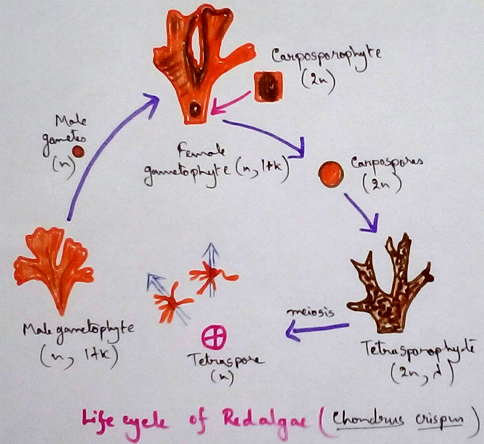Rhodophyceae
Red algae are known as Rhodophycae.
General characteristics of rhodophycae-
Algae are non-vascular, aquatic forms which possesses accessory spores for asexual multiplication and non-jacketed gametangial for sexual reproduction. But they do not have embryo forming stage. It includes in the kingdom plantae. According to presence of pigments algae can be divided into- chlorophyceae (green pigments chlorophyll is present), phaeophyceae (fucoxanthine for brown colour), and rhodophycae (phycoerithrin for red color).
Special Characteristics of the rhodophycae are mentioned below:
1. Maximum number of the algae are marine (except few are fresh water).
2. Some are color less and parasitic in nature that is they are unable to make their food themselves.
3. Rhodophycae do not have any motile stage and Thallophyta- in nature.
4. There structure can be unicellular, filamentous, parenchymatous and pseudoparenchymatous. Chloroplasts commonly discoid, without chloroplasts, endoplasmic reticulum.
5. Cell wall contains cellulose and phycocolloid like agar, carrageenan and funori.
6. Food is reserved as floridian starch formed in the cytoplasm, outside the chloroplasts.Mitosis closed,centrioles lacking, polar rings are present. Cleavage incomplete in most algae,presence of pit connection and pit plugs in most.
7. Rhodophycae contain female sex organ called carpogonium. It is flask shaped with long receptive neck called trychogyne.
8. Red algae contains male sex organ called spermatangium . Male sex organ contains non-flagellate gametes called spermatia.
9. External fertilization takes place. Post fertilization changes are complicated.
10. Some algae deposit calcium carbonate on their surface. This algae is know as coralline algae. Example of coralline algae is Corallina. This algae help in developing coral reefs along with corals.
11. Chloroplasts( chromatophores) have monothylakoid lamellae. Photosynthetic pigments include chlorophyll a, chlorophyll d (doubtful), carotenoids and phycobilins (phycoerithrin, phycocyanin, allophycocyanin). Red is due to phycoerithrin.
12. Life cycle is isoor heteroteromorphic, generally extended and triphasic.
Economic importance of red algae are:
• Used as edible food – Some red algae like Porphyra or Laver, Rhodymenia, Chondrus or Irish Moss (Gracilaria, Gelidium) are used as food or food processing.
• Extraction of bromine – At first bromine was extracted from red algae called Rhodomela.
• Used in microbiological media preparation - Gelidium, Gracilaria etc are used to yield agar which is used in culture media, media stabilizer and media thickener.
• Used as agrophyte – Gelidella acerosa. is used as an agrophyte.
• Uses as adhesive – funori acts as an adhesive agent.
• Clearing agent – Carrageenin acts as a clearing agent.
• Emulsifiers – Chondrus or Irish Moss act as emulsifiers.
• Anti bacterial agent - Polysiphonia kills microbes as it act as anti bacterial agent.
Questions and answers on Rhodophyceae:
1. Name a few fresh water representative of red algae?
Compsopogon, Lamanea, Thorea.
2. Name a red algae growing in mangroves?
Caloglossa leprieurii
3. Name some unicellular red algae.
Porphyridium, Cyanidium.
4. What are pit plugs?
In a majority of red algae, cleavage is incomplete. Subsequently a protoplasmic connection is established between cells. Soon the connection becomes closed by a proteinaceous stopper called pit plug.
5. What is NAO?
Nuclear associated organelle (NAO) is a distinctive organelle occurring at mitotic spindle poles in red algae.
From Rhodophyceae to HOME PAGE
Recent Articles
-
What Is Plasma? | Blood Plasma | Proteins | Nutrients | Cholesterol
Nov 07, 25 10:29 AM
Blood is a mobile fluid which is a connective tissue and is derived from the mesoderm like cell any other connective tissue. Colour of blood is reddish and that flows inside the blood vessels by means… -
Disorders of Respiratory System | Tuberculosis | Pleurisy | Emphysema
Oct 28, 25 11:39 PM
Tuberculosis is very common disease and is caused by a type of bacteria called Mycobacterium tuberculosis. This disease causes different trouble in the respiration and infection of several parts of th… -
Regulation of Respiration | Respiratory Centres | Inspiratory Area |
Oct 14, 25 12:13 AM
Respiratory Centre is the area that controls the rate of respiration and it is observed to be located in medulla oblongata and pons. Respiratory Centre has the following will dispersed components like… -
Explain Transport of Gases | External Respiration | Tissue Respiration
Oct 09, 25 11:35 PM
In humans gaseous exchange is completed in the following ways the steps are - External Respiration or Breathing - Breathing in false taking in of Oxygen and giving out of carbon dioxide in the body. M… -
Kind and Number of Teeth | Location of Teeth in Mouth | Care of Teeth
Sep 11, 25 12:52 AM
Kind and Number of Teeth






New! Comments
Have your say about what you just read! Leave me a comment in the box below.